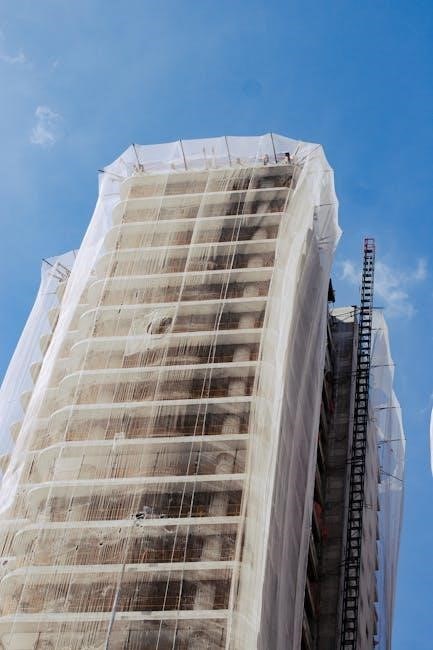A building construction checklist ensures compliance with standards, enhances efficiency, and reduces risks. It covers stages from site preparation to project close-out, providing a structured approach for successful project execution.
1.1 Importance of Using a Construction Checklist
A construction checklist is essential for ensuring projects meet quality standards, legal requirements, and safety protocols. It helps avoid rework, delays, and cost overruns by identifying potential issues early. Checklists ensure accountability, improve communication among stakeholders, and provide a clear roadmap for compliance. They also streamline inspections, documentation, and handover processes, making it easier to track progress and maintain consistency across all phases of construction. Regular use of checklists fosters a culture of quality and safety, ensuring that every aspect of the project is thoroughly addressed and verified.
1.2 Benefits of a Comprehensive Construction Checklist
A comprehensive construction checklist enhances project efficiency, ensures compliance, and minimizes errors. It streamlines processes, reduces delays, and improves accountability by outlining clear tasks and responsibilities. Checklists also facilitate better risk management, identifying potential issues before they escalate. They promote consistency, ensuring all stages meet quality and safety standards. Additionally, checklists simplify documentation, provide a transparent audit trail, and support handover processes. By covering all aspects from planning to completion, they help deliver projects on time, within budget, and to the satisfaction of all stakeholders.

Pre-Construction Phase Checklist
The pre-construction phase involves site preparation, land ownership verification, and obtaining necessary approvals and permits. It also includes reviewing architectural and structural plans for compliance and accuracy.
2.1 Site Preparation and Land Ownership Documents
Site preparation involves clearing land, removing debris, and ensuring proper grading. Land ownership documents must be verified to confirm legal rights and boundaries. Ensure all signatures are valid and approvals are in place. Conduct soil tests to assess ground conditions. Maintain a record of all activities and document compliance with local regulations. Proper site preparation and verified ownership documents are critical for a smooth construction process and avoiding legal disputes. Ensure all necessary permits are obtained before commencing work.
2.2 Approvals and Permits Required
Obtaining necessary approvals and permits is crucial before starting construction. Ensure zoning and land-use permits are secured. Building permits must be approved, and environmental clearances verified. Fire safety and structural integrity approvals are mandatory. All permits should be displayed at the site for inspection. Delays in obtaining approvals can halt progress, so plan accordingly. Ensure compliance with local regulations and submit required documentation promptly. Missing permits can lead to legal issues and project delays. Verify all approvals are in place before commencing work.
2.3 Review of Architectural and Structural Drawings
Reviewing architectural and structural drawings is essential to ensure project feasibility and compliance with safety standards. Verify that all elements, including beams, columns, and foundations, are accurately represented. Check for compliance with building codes and ensure the design aligns with structural integrity. Confirm that the drawings match the approved plans and incorporate any revisions. This step ensures clarity for contractors and prevents costly rework. Proper documentation and approval of drawings are critical before proceeding to the construction phase.
Procurement and Planning Phase
The procurement phase involves budgeting, scheduling, and selecting contractors. Ensure materials align with specifications and timelines. Verify contractor qualifications and compliance with building codes and standards.
3.1 Material Procurement Checklist
A material procurement checklist ensures all necessary supplies are sourced and delivered on time. Verify that materials meet project specifications, are approved by suppliers, and comply with building codes. Include items like cement, steel, bricks, and electrical components. Ensure proper documentation, such as delivery receipts and material certification. Regularly audit the procurement process to avoid delays and ensure quality. This checklist helps maintain transparency and accountability in sourcing materials, ensuring smooth project execution and adherence to safety standards.
3.2 Contractor and Supplier Selection Criteria
Selecting reliable contractors and suppliers is critical for project success. Evaluate their reputation, experience, and financial stability. Verify past performance and client reviews. Ensure they hold necessary certifications and adhere to industry standards. Conduct thorough interviews and assess their ability to meet timelines and budgets. Request detailed proposals and compare quotes to find the best fit. Include contract terms, payment schedules, and dispute resolution mechanisms. A well-vetted selection ensures quality workmanship and avoids delays, fostering a collaborative and productive project environment.
3.3 Project Schedule and Timeline
A well-defined project schedule is essential for ensuring timely completion. Break the project into phases with clear milestones and timelines. Assign responsibilities to team members and monitor progress regularly. Use tools like Gantt charts to visualize tasks and deadlines. Regularly review and adjust schedules to address delays or changes. Ensure all stakeholders are informed of timelines and expectations. A clear and realistic project schedule helps maintain organization, accountability, and alignment with project goals, ultimately leading to successful and on-time delivery.

Foundation and Structural Work
Foundation and structural work are critical phases requiring thorough inspection. Check for proper foundation alignment, structural integrity, and compliance with approved plans and safety standards.
4.1 Foundation Inspection Checklist
A foundation inspection checklist ensures the base structure meets safety and durability standards. Key items include verifying site preparation, foundation alignment, concrete strength, and formwork accuracy. Inspect for proper reinforcement placement, adequate drainage systems, and compliance with approved architectural and structural drawings. Check for any cracks or defects in the foundation walls and slab. Ensure all materials used meet specified quality standards and that the foundation is level and plumb. Proper documentation of findings is essential for future reference and project continuity.
4.2 Structural Steel and Concrete Work Inspection
Inspect structural steel for proper alignment, connections, and welding quality. Verify concrete pours meet specified strength and finish requirements. Check formwork accuracy and reinforcement placement. Ensure all materials comply with approved drawings and quality standards. Test concrete curing and finishing techniques for durability. Verify proper safety measures, such as support systems and fall protection. Document any defects or deviations for corrective action. Ensure compliance with safety protocols and building codes to maintain structural integrity and stability throughout the construction process.
Superstructure Construction
Superstructure construction involves building walls, floors, and roofing. Inspect masonry, brickwork, and waterproofing. Ensure compliance with approved drawings and quality standards for durability and structural integrity.
5.1 Masonry and Brickwork Inspection
Inspect masonry and brickwork for material quality, alignment, and mortar joints. Ensure courses are level, plumb, and properly bonded. Check for cracks, uneven surfaces, and structural integrity. Verify adherence to approved drawings and specifications. Conduct tests for strength and durability. Document defects and ensure repairs are made before proceeding. Maintain detailed records of inspections and approvals for compliance with quality standards and building codes.
5.2 Roofing and Waterproofing Checklist
Verify roofing materials meet specifications and are installed correctly. Inspect for proper flashing, sealing, and drainage systems. Ensure waterproofing membranes are intact and applied as per manufacturer guidelines. Check for any leaks, punctures, or damaged areas. Test roofing components for durability and weather resistance. Confirm all safety standards are met during installation. Maintain detailed documentation of inspections and corrective actions taken to ensure long-term structural integrity and prevent water damage.
MEP (Mechanical, Electrical, Plumbing) Systems
MEP systems require thorough inspections to ensure compliance with codes and proper installation. Verify electrical circuits, plumbing connections, and HVAC components for functionality, safety, and durability.
6.1 Electrical Installation Checklist
An electrical installation checklist ensures all components are safely and correctly installed. Verify circuit breakers, wiring, grounding, and connections. Check compliance with local electrical codes and standards. Ensure proper labeling and documentation for future maintenance. Test all systems to confirm functionality and safety. Address any defects or omissions promptly to avoid hazards. Proper installation prevents electrical fires and ensures reliable power supply. Regular inspections maintain system performance and longevity, adhering to safety protocols and regulatory requirements.
6.2 Plumbing and HVAC System Inspection
A thorough inspection of plumbing and HVAC systems ensures functionality and safety. Check pipes for leaks, water pressure, and drainage efficiency. Verify HVAC components, including ductwork, vents, and thermostats, for proper operation. Ensure compliance with local codes and standards. Test water quality and heating/cooling performance. Address any issues promptly to prevent system failures. Proper installation and maintenance prevent costly repairs and ensure energy efficiency. Regular inspections guarantee comfort, health, and safety for building occupants, aligning with regulatory and quality standards.

Safety and Quality Control
Ensuring compliance with safety standards and quality assurance is crucial. Conduct regular site inspections, enforce safety protocols, and maintain detailed documentation for accountability and process improvement.
7.1 Safety Inspection Checklist
A safety inspection checklist is essential for ensuring a hazard-free construction site. It includes verifying personal protective equipment (PPE), equipment functionality, fall protection measures, and fire safety systems. Regular inspections help identify potential risks, such as unstable structures or improper scaffolding. Compliance with safety regulations and standards must be documented. Additionally, the checklist should cover emergency exit access, first aid availability, and proper signage. Corrective actions for identified hazards should be tracked and implemented promptly to maintain a safe working environment. Regular audits ensure ongoing adherence to safety protocols.
7.2 Quality Control and Testing Procedures
Quality control and testing procedures are critical for ensuring materials and workmanship meet project specifications. Regular inspections and tests, such as concrete strength and steel reinforcement, are conducted. Documentation of test results is mandatory. Non-compliant work must be addressed with corrective actions. Compliance with building codes and standards is verified at each stage. A detailed quality control checklist ensures all aspects, from materials to finishes, are inspected and approved. Proper documentation and reporting are essential for final handover and certification.

Project Close-Out and Handover
Project close-out involves final inspections, snag list creation, and documentation preparation. All approvals and certifications are verified before handover to ensure compliance with project requirements.
8.1 Final Inspection and Snag List
The final inspection evaluates all systems, materials, and finishes to ensure compliance with project plans and standards. A snag list is created to document any defects or incomplete work. This list is reviewed and addressed by contractors before project handover. It ensures all issues are resolved, and the project meets quality and safety requirements. Proper documentation and sign-offs are essential for a smooth transition to the client.
8.2 Documentation and Handover Process
Documentation includes all project-related records, such as architectural drawings, material certificates, and maintenance manuals. The handover process involves transferring these documents to the client or facility manager. It ensures seamless operation and compliance with regulations. Proper documentation also includes warranties, operating instructions, and emergency procedures. A comprehensive handover meeting is conducted to review all materials, addressing any questions or concerns. This ensures the client is fully prepared to manage the completed project effectively.

